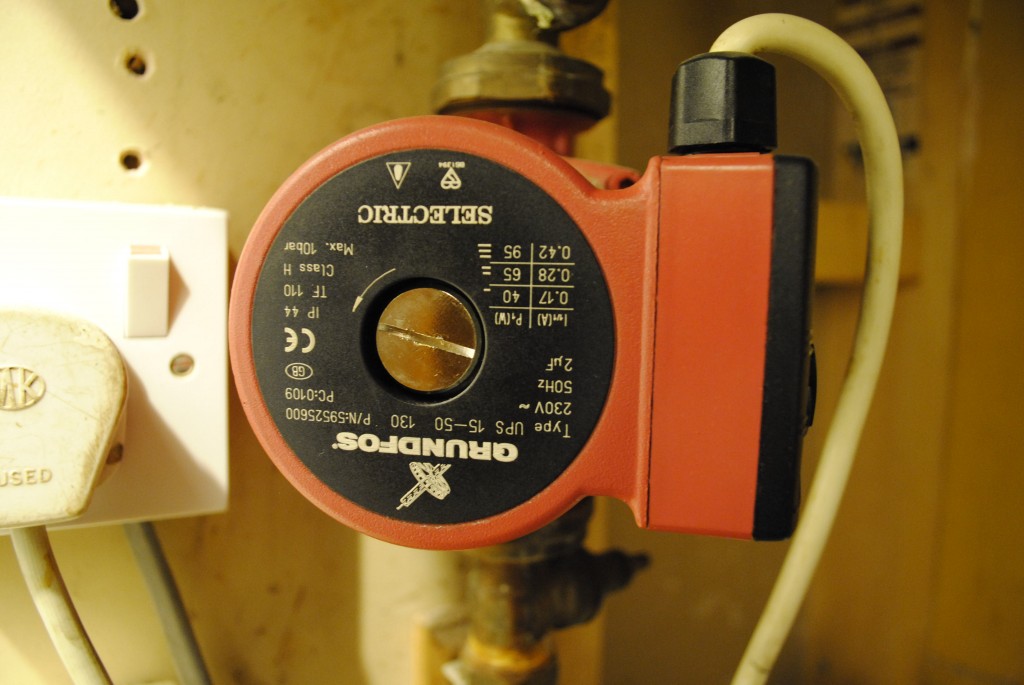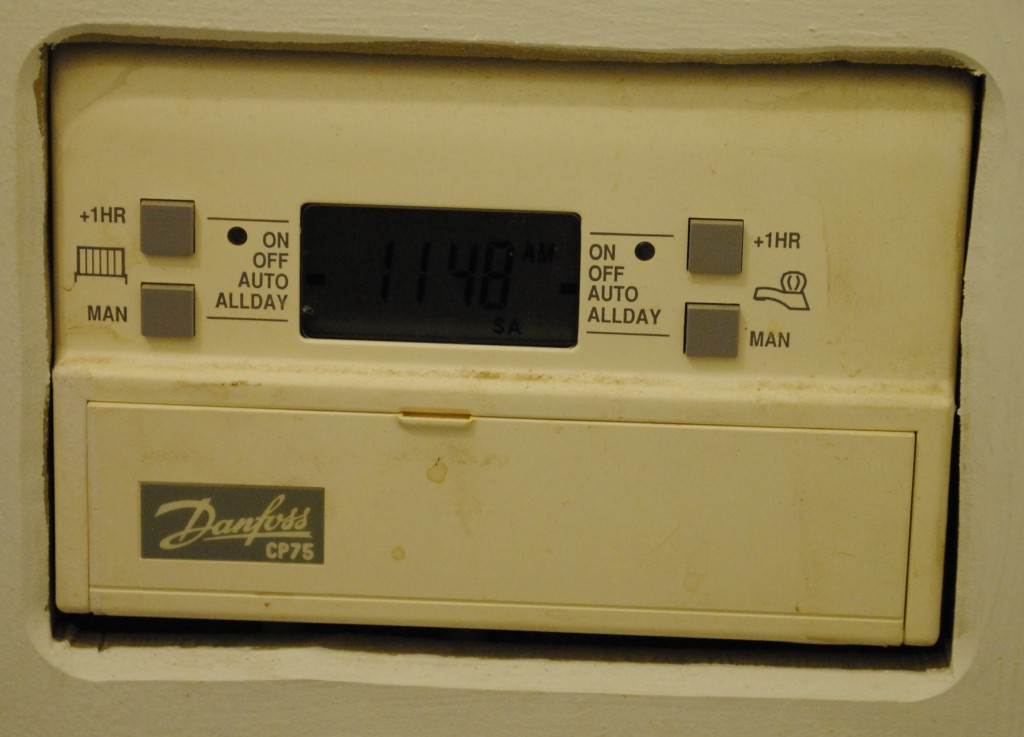
I lost last weekend, although not in a hotel in Amsterdam[1]
I lost the weekend trying to find out what was wrong with my central heating system. What follows is one of the most bizarre journeys of home maintenance that I’ve ever been on.
It all started when I was woken on Friday by a nasty groinching noise – the sort of groinching nose that an expensive electro-mechanical device makes shortly before it relieves you of the contents of your wallet. Worryingly the only two candidates in the next room were the central heating pump and diverter valve, both of which definitely fall into the category of expensive.
I crossed my fingers that some sort of airlock was responsible so bled the pump and a couple of nearby radiators. Hey presto the system burst back into life so I went back to bed.
On Friday night however, whilst I was cooking, I heard a very similar nasty groinching sound coming from the boiler. My wallet yelped, then ran away and hid. Praying to the gods of home maintenance that I wasn’t going to need to call a plumber I hoped that the boiler was simply resonating a sound that came from somewhere else. Regardless, the system was clearly unhappy so I went upstairs and turned the central heating off, but for some reason I can’t quite fathom left the hot water on.
It’s at this point I need to mention that we have a Y-Plan system – the water that the boiler heats can either be used to heat the hot water tank or the radiators depending on the position of the mid-position (diverter) valve.
What happened next surprised me slightly. The boiler fired up and the pump started running – no nasty sounds. So the problem was clearly not the pump and I started to look very suspiciously at the diverter valve. Motor valves are notorious for failing, jamming and just generally going wrong. So I grabbed the “manual” lever and waggled it about. It moved freely but something else interesting happened – the boiler stayed running no matter whether the diverter valve was sending water to the hot water cylinder or round the central heating circuit.
So I left the valve in the mid-position sending hot water to both circuits and we had heat in the radiators. Until the hot water cylinder got up to temperature, which was rather too soon for my liking.
It’s times like this I’m glad that I have a chunky wood burner.
I had things to do on the Saturday but I did manage to get rather a lot of reading done – service manuals for everything in the system and at the end of it all everything was still as clear as mud. One thing that did occur to me though was to measure the boiler input voltage. When the system thought it was heating hot water – regardless of what it was actually heating – there was a something around 240V at the boiler.
If I switched it to central heating it dropped to 150V. So the nasty groinching sound – the sound like something failing to start was probably not because of a mechanical failure but because of a lack of juice.
I breathed a sigh of relief – the fault was electrical. The only component unique to the central heating circuit was the room thermostat my beady eye of suspicion fell upon it. Basically a thermostat is just a temperature controlled switch so I decided to bypass it, just to test. In theory this was a perfectly valid thing to do – if the central heating worked with the thermostat bypassed it would point very strong indeed at the thermostat being at fault. The problem was that the central heating control circuitry is a mixture of two different manufacturer’s wiring instructions and I misinterpreted. So instead of bypassing the thermostat I actually shorted out the output of the programmer. I had a pretty good idea what I’d done when I flipped the “On” switch and heard the almost instant clank of the trip switch flipping “Off”. I may have sworn. Quite a lot. This is because I’m a trained and apprenticed electronic technician and as such this kind of control circuitry is as much, if not more my domain of expertise as an electrician. So making this sort of cock-up is highly embarrassing. I swore some more, to make sure there was enough swearing to communicate just how annoyed with myself I was.
Then I removed the erroneous link wire and prayed once again to the Gods of home maintenance, hoping this time that my stupid mistake hadn’t fried anything expensive. After checking the circuity and components for any physical signs of damage I crossed my fingers and flipped the switch back on again. Initially I did think I’d got away with it. Nothing fizzed, popped or banged, there were no strange smells and nothing appeared to be getting hotter than it should. Nothing that is apart from the boiler which was merrily heating water and the pump was happily whirring away. This was odd because both the central heating and the hot water were turned off at the time.
At least I knew I didn’t need a plumber. I knew who to call; Ghostbusters.
Now I’ve never been particularly frightened by the paranormal so I thought I’d take this opportunity to do some investigation. If I turned the thermostat up to 30 degrees the boiler stopped. If I turned it down to 10 degrees and the boiler started again – the boiler, pump and thermostat were working perfectly.
The real issue though was that I’d made matters worse. Not only did I have the problem of the nasty groinching sound to solve but my central heating was now being operated from beyond the veil. So I grabbed a plastic colander, put it on my head[2] and began my journey into the supernatural. I’d recently short-circuited the output of the programmer and now there was a switching malfunction. I had a pretty good idea what the problem was. Inside the Danfoss CP75 programmer are two relays, one for the hot water circuit and one for the heating. With it all safely isolated I popped the case off the central heating relay and found precisely what I expected – a miniature poltergeist with a teeny-tiny arc welder had mischievously welded the contacts together.
The real explanation is a little more mundane – this is not unusual for a relay that had been massively, but only momentarily, overloaded (say by some idiot shorting the output). As the contacts meet the sheer amount of power melts the surface and they weld together. The breaker then cuts out and prevents further damage. If you’re lucky the damage is only superficial and a little tap will break the weld.
I was lucky. What I did notice however was how much crud there was around the contacts. A few minutes with some fine grade wet-and-dry soon had them looking like new.
I put the programmer back and hey presto the system now works perfectly both for hot water and heating. Apparently so much crud had built up on the relay contacts for the central heating circuit that it was no longer making proper contact at all.

A good result in the end. Sure calling a “heating engineer” might have saved me quite a lot of time – someone with experience would probably have identified the programmer much more quickly than me. But then I wouldn’t have got to run around the house with a kitchen utensil on my head singing old Dean Martin tracks[2]
They’re also unlikely to have identified the output relay directly. Those programmers are no longer made so not only would a “heating engineer” be charging me a premium for a new programmer I’d be facing a substantial bill for wiring it in, too.
[1] If you don’t get the reference search for Lloyd Cole & The Commotions – Lost Weekend
[2] Insert “as is the tradition of my people” or “as my faith demands” as you choose.